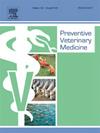Financial impact of low pathogenic avian influenza virus subtype H9N2 on commercial broiler chicken and egg layer production systems in Pakistan
IF 2.2
2区 农林科学
Q1 VETERINARY SCIENCES
引用次数: 0
Abstract
Low Pathogenic Avian Influenza (LPAI) subtype H9N2 is endemic in Pakistan and impacts poultry farming through disease related mortality, poor weight gain and reduced egg production. This study aims to estimate the farm-level financial impact of LPAI H9N2 infection on commercial broiler and layer production systems in Pakistan.
A questionnaire based cross-sectional survey of 138 broiler farms and 136 layer farms in Pakistan was conducted in 2019. Primary data collected by cross-sectional survey along with expert opinion and published literature were used to parameterize five stochastic production and gross margin models for three broiler and two layer production systems: fully integrated production (FIP), partially integrated production (PIP) and independent farming production (IP) systems. Partial budget analysis were then carried out to estimate the financial impact of LPAI H9N2.
Results indicate that in broiler production systems, starting with 35,000 day old chicks (DOC) per batch, the net cost of disease (million PKR/production cycle) was estimated at 4.10 (14,862 USD), 4.62 (16,747 USD) and 2.46 (8917 USD) for IP, PIP and FIP systems, respectively. The disease produced a negative gross margin (defined here as revenue minus replacement and variable costs) in IP (-53 PKR (-0.19 USD)/DOC bought) and PI (-25 PKR (-0.091 USD)/DOC bought) systems, while remained positive for FIP systems (87 PKR (0.32 USD)/DOC bought). For layer production systems, (mean flock size as 48,000 DOCs) the net cost (million PKR/production cycle) was 29.75 (107,095.21 USD) and 29.51 (106,223.45 USD) IP and PIP systems, respectively, and produced negative gross margin in both systems.
The outcomes of the study highlight the vulnerability of independent and partially integrated production systems to the disease. These findings also offer a decision-making tool to the farmers and policy makers to evaluate avian influenza surveillance systems and control interventions in Pakistan.
H9N2 亚型低致病性禽流感病毒对巴基斯坦商品肉鸡和蛋鸡生产系统的财务影响
H9N2 亚型低致病性禽流感(LPAI)是巴基斯坦的地方病,通过与疾病相关的死亡率、增重不良和产蛋量下降影响家禽养殖。本研究旨在估算低致病性禽流感 H9N2 感染对巴基斯坦商业肉鸡和蛋鸡生产系统造成的农场级财务影响。通过横断面调查收集的原始数据以及专家意见和公开发表的文献被用于对三种肉鸡和两种蛋鸡生产系统的五个随机生产和毛利率模型进行参数化:完全一体化生产系统(FIP)、部分一体化生产系统(PIP)和独立养殖生产系统(IP)。结果表明,在肉鸡生产系统中,从每批 35,000 只日龄雏鸡(DOC)开始,估计 IP、PIP 和 FIP 系统的疾病净成本(百万巴基斯坦卢比/生产周期)分别为 4.10(14,862 美元)、4.62(16,747 美元)和 2.46(8917 美元)。该疾病在 IP(-53 人民币(-0.19 美元)/购买的有机肥)和 PI(-25 人民币(-0.091 美元)/购买的有机肥)系统中产生负毛利率(此处定义为收入减去替代成本和可变成本),而在 FIP 系统中保持正毛利率(87 人民币(0.32 美元)/购买的有机肥)。对于蛋鸡生产系统(平均鸡群规模为 48,000 DOCs),IP 系统和 PIP 系统的净成本(百万巴基斯坦卢比/生产周期)分别为 29.75(107,095.21 美元)和 29.51(106,223.45 美元),两个系统的毛利率均为负值。这些研究结果还为农民和政策制定者评估巴基斯坦禽流感监测系统和控制干预措施提供了决策工具。
本文章由计算机程序翻译,如有差异,请以英文原文为准。
求助全文
约1分钟内获得全文
求助全文
来源期刊

Preventive veterinary medicine
农林科学-兽医学
CiteScore
5.60
自引率
7.70%
发文量
184
审稿时长
3 months
期刊介绍:
Preventive Veterinary Medicine is one of the leading international resources for scientific reports on animal health programs and preventive veterinary medicine. The journal follows the guidelines for standardizing and strengthening the reporting of biomedical research which are available from the CONSORT, MOOSE, PRISMA, REFLECT, STARD, and STROBE statements. The journal focuses on:
Epidemiology of health events relevant to domestic and wild animals;
Economic impacts of epidemic and endemic animal and zoonotic diseases;
Latest methods and approaches in veterinary epidemiology;
Disease and infection control or eradication measures;
The "One Health" concept and the relationships between veterinary medicine, human health, animal-production systems, and the environment;
Development of new techniques in surveillance systems and diagnosis;
Evaluation and control of diseases in animal populations.
 求助内容:
求助内容: 应助结果提醒方式:
应助结果提醒方式:


